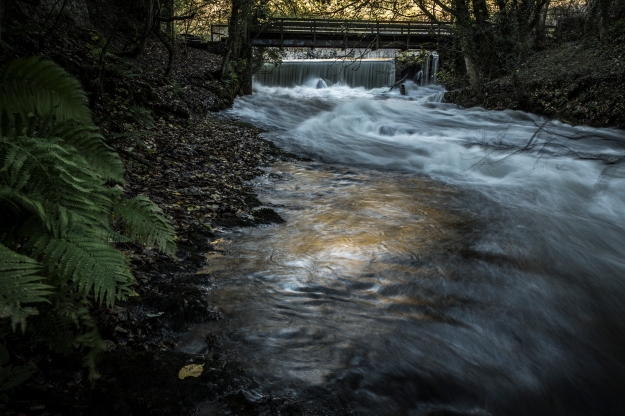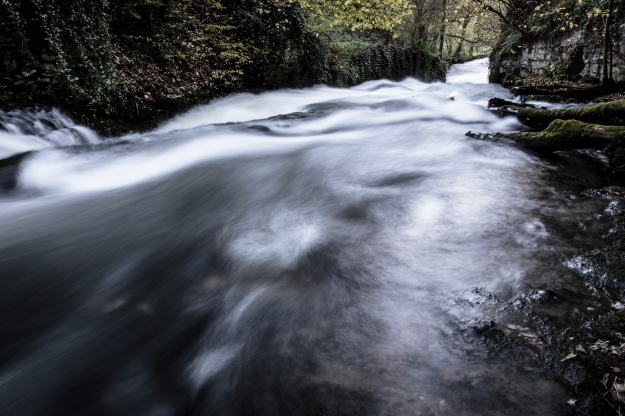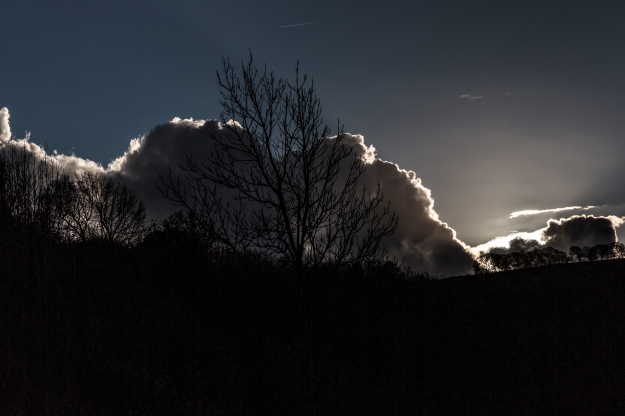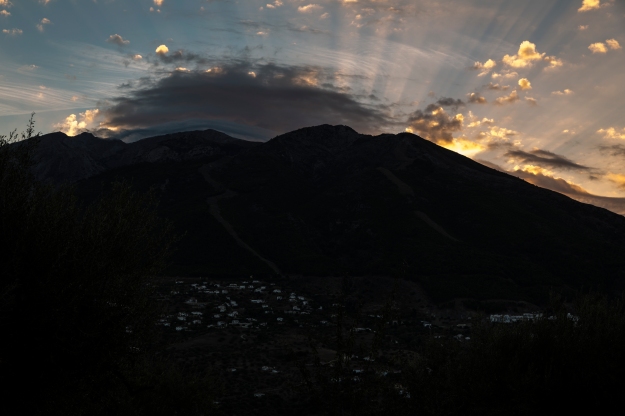This exercise is designed to help practice the use of exposure as a compositional tool, for example to create a particular mood or intensity of colours. It asks for four to six photographs which are deliberately lighter or darker than average. I have chosen a group of four images all darker than the average exposure at the time. The first three images were taken in the Peak District, England, the fourth in Málaga, Spain.
England
The River Wye flows through Water-cum-Jolly Dale and over a weir near the old Cressbrook Mill before travelling on to Bakewell. On the day I took the first two images I travelled to the area with a Simon and Garfunkel song-inspired idea in my head about a ‘Bridge Over Troubled Waters’. These first two images capture the turbulence in the river as it flows from the sunlight through a darker part of its journey before reaching sunlight again.
The exposure plan for the two images was influenced by three considerations. First, to have an aperture small enough to give sufficient depth of field from the foreground through to the background. Second, to have a shutter speed slow enough to allow the river to reveal its lines, curves, textures and whiteness of the turbulent water. Third to underexpose sufficiently to help reinforce the idea of ‘troubled’ waters through a darker visual feel to the image. The first image (Water-Cum-Jolly 1) also needed a darker exposure to help strengthen the colour of a reflection of sunlight in the foreground. In the second image particularly I wanted to create a visual contrast between the dark static river banks and the luminosity and fluidity of the river.
The next image (Monsal Head) came from a chance encounter with the setting sun as I arrived back at the car park which looks over Monsal Dale. The sun was falling below the hill and creating an interesting effect between the shape of the clouds and the glow of the sun. It was still an hour or more before sunset so the colours were cooler than a red sunset. The white balance for the image is 4900K and I reduced the vibrance in processing to take more of the colour out of the image to help give a ‘moonlit’ feel for the image.
At a recent exhibition of landscape paintings in MáIaga (‘Courbet, Van Gogh, Monet, Léger: From naturalist landscapes to the avant-gardes in the Carmen Thyssen collection’) I saw ‘Nocturnal Landscape’ by Eliseu Meifrèn I Roig and found the nature of the light with the soft but cold luminosity of the moonlight very appealing.
The image was exposed for the brighter area of the sky to retain the highlight details although the image still needed a little adjustment of highlights (-24) to recover some details in the area of sky near to the sun. Shadows were also boosted in processing (+62) to help give a ‘heavier’, more sombre feel to the image and to help hide the cluttered, unattractive shrubbery in the foreground.
Spain
The fourth image was taken at sunrise looking over the valley from my house in Spain to the mountains towards La Maroma. The sky was changing rapidly and the ray effect only lasted for about two minutes. The aim with the image was to expose to accentuate the colours, shapes and patterns in the sky at the expense of the detail in the mountain side. In processing I adjusted the highlights (+7), shadows (-7) and blacks (+31) to provide a little more luminance in the sky, strengthen the texture of the lighter clouds while enhancing the sombre feel of the dark cloud settled on the top of the mountain. Although I wanted the mountain side to act as a dark contrast to the rising sun I also wanted to retain some detail of the houses to suggest there is more to see as the sun overcomes the mountain and dark cloud to bring light to the valley and the people who live there.



